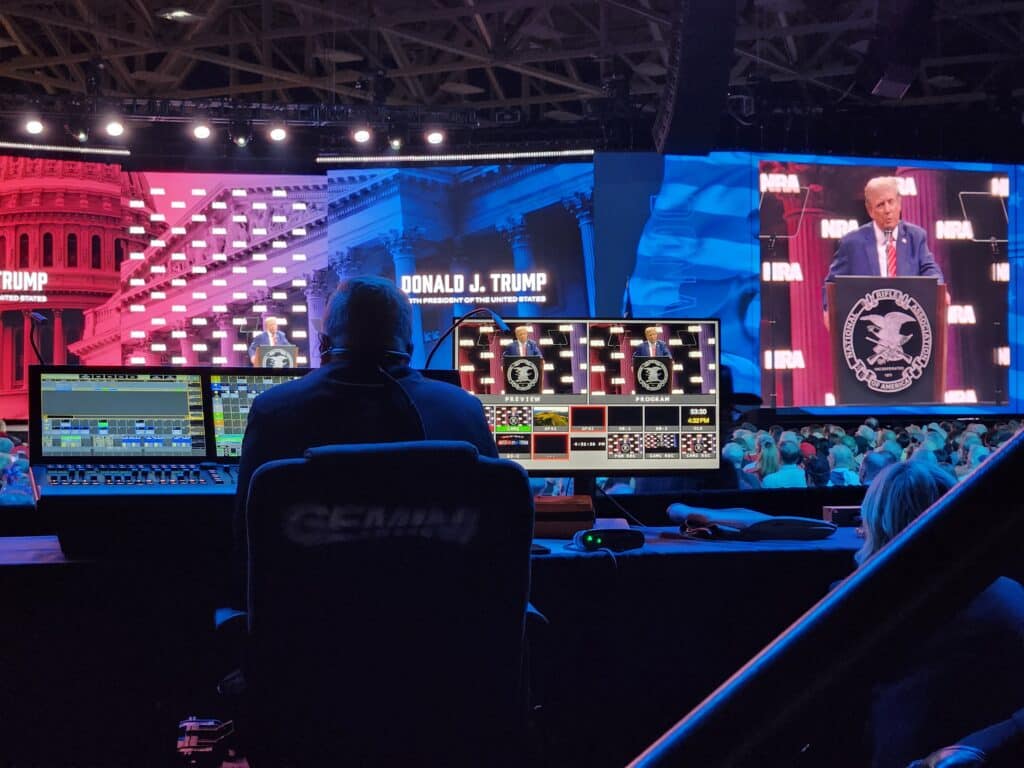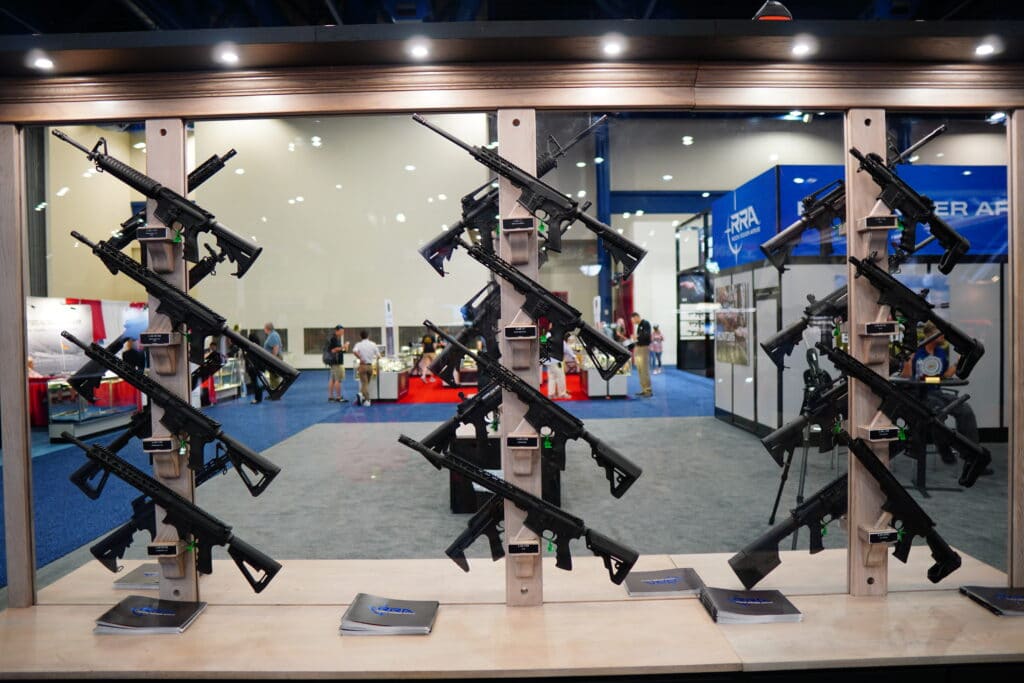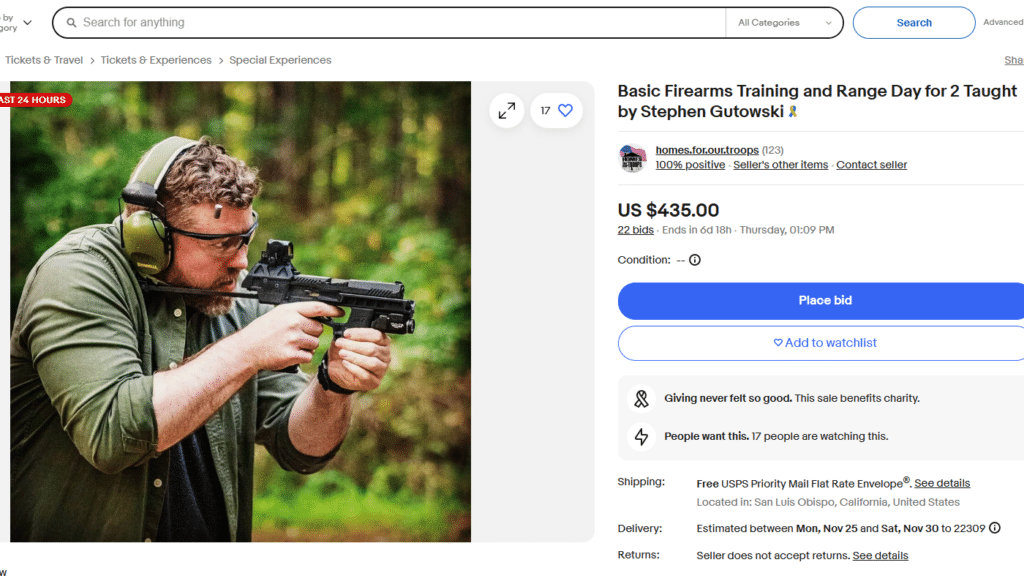The main promise Donald Trump made to gun voters was that he’d undo President Joe Biden’s gun actions. So, this week, Contributing Writer Jake Fogleman is walking through what it would take to do that and where the biggest challenges lie.
He also takes a look at the novel approach one federal judge took to striking down the Illinois “assault weapons” ban under a novel standard created by the Seventh Circuit, which was meant to uphold that ban. It’s a pretty fascinating look at one of the big gun-rights battles playing out in the lower federal courts right now.
Plus, I talk with Punchbowl’s John Bresnahan about the new Senate Majority Leader and what the next Congress might accomplish on gun policy during this week’s podcast. He’s one of the best congressional reporters around. So, it’s definitely a good episode if you want to understand what’s coming and what’s not.
Also, there’s less than a week left to bid on my charity range day! Come shoot with me AND help build homes for severely wounded veterans. I guarantee it will be a good time!

Analysis: How Trump Can and Can’t Undo Biden’s Gun Policies [Member Exclusive]
By Jake Fogleman
Reversing all of his predecessor’s gun-control policies is one of the few concrete policy pledges President-elect Donald Trump made to gun voters on the campaign trail. Fulfilling that pledge could get complicated.
Shortly before securing his party’s nomination this spring, Trump distilled his gun policy goals to a crowd of NRA members at the group’s Great American Outdoor Show.
“Every single Biden attack on gun owners and manufacturers will be terminated my very first week back in office,” Trump told the crowd.
While the promise reflects a degree of typical Trumpian hyperbole, there are a few Biden actions that Trump could derail with immediate dispatch.
The fate of the White House Office of Gun Violence Prevention is a prime example. Just this past week, the National Shooting Sports Foundation called on Trump to disband it on day one of his new term, something he could do without challenge. The office, barely a year old, was created by President Joe Biden through unilateral executive authority and could be dispensed with in the same fashion. Alternatively, Trump has plenary authority to simply re-staff the office with employees more sympathetic to gun rights than its current occupants and redirect its mission to one focused on promoting gun owners’ interests.
The same is true of the makeup of the ATF and its enforcement priorities under the current administration. President Trump could immediately fire current ATF director Steve Dettelbach, something he has previously pledged to do. Replacing him with a new permanent director of Trump’s choosing would, of course, require Senate confirmation. Still, with his party holding a three-seat majority, that should be reasonably easy to achieve–depending on how controversial the nominee is.
Even before a new permanent director is confirmed, Trump could appoint an acting director, something he had for the entirety of his first term, and influence their enforcement priorities. Under Dettelbach’s tenure and at the behest of Biden, the agency has pursued a “zero tolerance” enforcement policy against federally licensed gun dealers that has rankled the industry’s relationship with the agency as license revocations have skyrocketed. Trump could immediately order his acting director to reverse course on this inspection and revocation crackdown.
Beyond agency personnel and priorities, the road to undoing President Biden’s gun-control agenda becomes much less immediate and straightforward.
Some of Biden’s most consequential gun actions came in the form of official ATF rules, such as his ban on so-called ghost gun kits, reclassification of pistols equipped with stabilizing braces, and expansion of who must be federally licensed in order to sell used guns. Undoing these regulatory changes won’t be as simple as signing a day-one letter.
While the Trump administration has the authority to direct the ATF to rescind those rules, the process for seeing that carried out is as slow and prone to legal challenges as the initial rule rollouts themselves under the terms of the Administrative Procedures Act (APA).
“The APA’s rulemaking requirements generally apply to the repeal and amendment of rules, as well as to their initial issuance,” a 2021 report from the Congressional Research Service reads. “Thus, if an agency seeks to rescind or change an existing legislative rule, it generally must do so in compliance with the APA’s requirements, unless an exception applies.”
That means issuing a notice of a proposed rule change, giving the public an opportunity to comment on said proposed change, and then publishing a final rule to take effect a month after this process is complete. This process would also be subject to the same types of lawsuits that President Biden’s gun-control rules have drawn.
“Courts generally apply the same scrutiny to review an agency’s rescission of a rule as they do for a rule’s issuance,” the CRS report reads. “An agency must explain its departure from prior policy and show that its new policy adheres to the underlying statute; is supported by ‘good reasons’; and is better, in the agency’s belief, than the prior policy. It must also address factual findings that are inconsistent with those supporting the former rule and consider ‘serious reliance interests’ affected by a change in policy.”
While, at first glance, it may seem like a repeal effort of executive orders that have been called into question by multiple federal judges would have a stronger legal leg to stand on, this exact scenario has proven challenging for Trump before.
In his first term, the Trump administration moved to undo President Obama’s unilaterally created Deferred Action for Childhood Arrivals (DACA) program, stating it believed the program was an unlawful exercise of agency authority and that Congress would have to act if it wanted the program to continue. After drawing lawsuits, the repeal effort ultimately reached the Supreme Court, where a 5-4 majority ruled that the Trump administration’s effort was an “arbitrary and capricious” violation of the APA for failing to properly articulate a policy rationale for the change and consider the degree to which there were “legitimate reliance interests” implicated by the change.
Withstanding legal challenges could prove especially challenging for a potential repeal of President Biden’s “ghost gun” rule. That rule is currently awaiting a Supreme Court opinion, and the tenor of oral arguments suggested that a majority of the justices are leaning toward upholding the rule as a proper reading of federal firearm statutes. If so, the Court may not be willing to let the ATF undo that reading under Trump.
Finally, by far the toughest hill to climb for the Trump administration’s stated goal of repealing all of the Biden administration’s gun achievements is the Bipartisan Safer Communities Act. When President Biden signed it in 2022, it became the first federal law to prohibit new groups of people from owning guns in nearly 30 years. Doing away with it would require an act of Congress.
Though Republicans will hold majorities in both chambers of the legislature starting next year, each is likely too slim to make the passage of a repeal bill feasible. Clearing the Senate would require seven Democratic votes to thwart an inevitable filibuster effort, even assuming unanimous Republican support to take on a repeal effort, which is unlikely. After all, 14 House Republicans and 15 Senate Republicans voted to support the bill in the first place.
Still, there’s clearly plenty of low-hanging fruit for the Trump administration to reach for right out of the gate. However, gun owners shouldn’t be surprised if the new administration can’t grasp everything Biden did. Ultimately, a full-scale reversal of the Biden administration’s gun-control gains is unlikely–even if Trump can get most of the way there.
Podcast: Punchbowl’s John Bresnahan on Guns in the Next Congress [Member Early Access]
By Stephen Gutowski
This week, we have a new Senate Majority Leader and are getting a clearer picture of what the next Congress will look like. But what will it do on gun policy?
To answer that question, we have one of the preeminent congressional reporters on the show. Punchbowl co-founder John Bresnahan has been covering Congress for decades now. He knows all of the key players in Congress, including new Majority Leader John Thune.
Bresnahan said Thune had the strongest pro-gun record of the three Senators who ran for the majority leader role. He said John Cornyn’s role in negotiating the Bipartisan Safer Communities Act hurt him in the race and may even have made the difference since it was a very close vote. He argued the entire Republican Senate leadership is strongly pro-gun now.
Still, Bresnahan doesn’t necessarily believe there are going to be a lot of opportunities for pro-gun legislation in the next Congress. With a 53-vote majority and the filibuster likely to remain, there probably aren’t any significant gun bills that can make it to President Donald Trump’s desk.
However, there are other ways Congress could have a big impact on gun policy over the next eight years. He said the longest-lasting impact will likely come from judicial appointments, and he noted the GOP will probably control confirmations for all eight years of Trump’s term.
You can listen to the show on your favorite podcasting app or by clicking here. Video of the episode is available on our YouTube channel. An auto-generated transcript is available here. Reload Members get access on Sunday, as always. Everyone else can listen on Monday.
Plus, Contributing Writer Jake Fogleman and I cover a significant new ruling out of Illinois, where a federal judge found the state’s ban on “assault weapons” unconstitutional. We also cover the growing chorus of voices calling on President-elect Trump to dismantle President Biden’s Office of Gun Violence Prevention, with the gun industry’s trade group formally making the request this week.
Charity Auction: Bid on a Range Day With Me!
I’ve got a great opportunity for you guys to not just meet me, but to come to the range with me AND help out disabled veterans! I’m auctioning off firearms training and a range day for two people through the annual Homes For Our Troops Celebrity Auction. The winner will get to meet me in either Northern Virginia or Southeastern Pennsylvania and head to the range for some fun and safe shooting.
The proceeds will go to Homes For Our Troops, a 501(c)(3) charity that builds custom homes for severely injured veterans. It has top ratings from the nation’s leading charity watchdogs, and nearly 90 cents of every dollar donated to it goes toward program services for the veterans.
I’m an NRA-certified firearms safety instructor. So, shooters of all skill levels are welcome. I can teach you how to fire a gun safely if you’ve never done so before, or we can have a bit of a competition if you’re a more experienced shooter. I’ll provide the guns and the ammo, but you’re also welcome to bring your own!

Analysis: How a Federal Judge Reinterpreted the ‘Military Arms’ Argument to Protect AR-15s [Member Exclusive]
By Jake Fogleman
After a federal appeals court wrote AR-15s and the magazines that typically come with them out of the Second Amendment, a federal judge has written them back in.
Last November, a Seventh Circuit Court of Appeals panel declined to enjoin Illinois’ ban on so-called assault weapons and large capacity magazines after ruling that each was too akin to military hardware to be counted as “arms” protected by the Second Amendment. Yet just last week, a US District Court judge under the Seventh Circuit’s jurisdiction struck down the exact same ban as unconstitutional.
In fact, he did so by relying on the circuit’s own words.
When the Seventh Circuit panel upheld Illinois’ ban, it set a new standard to determine whether a proposed gun law implicates the plain text of the Second Amendment–a key component of the Supreme Court’s Bruen test.
“In order to show a likelihood of success on the merits, the plaintiffs in each of the cases before us thus have the burden of showing that the weapons addressed in the pertinent legislation are Arms that ordinary people would keep at home for purposes of self-defense, not weapons that are exclusively or predominantly useful in military service, or weapons that are not possessed for lawful purposes,” Judge Diane Wood wrote in Bevis v. Naperville.
Wood drew specific attention to the “military use” prong. Relying on dicta from the Supreme Court’s Heller decision assuring other courts that the ruling did not prohibit regulation of machineguns used by the military (specifically the M16), she posited that civilian AR-15s are nearly indistinguishable from M16s. She concluded, therefore, that they are also “predominantly useful in military service” and may be banned.
Judge Stephen McGlynn came to a different conclusion regarding the “military use” of AR-15s and similar rifles when reviewing the case. While following the analytical structure handed down by the Seventh Circuit, he conducted his own inquiry into what makes a weapon “predominantly useful in military service.” Where the Seventh Circuit panel hand-waved away rate-of-fire differences between AR-15s and military service rifles, McGlynn found cause for highlighting the distinction.
“The commercially available AR-15’s external similarity to the M16 rifle and M4 carbine belies its nature, as its lack of burst or fully automatic fire fundamentally renders it a different weapon,” he wrote.
He also argued that rifles acquired for the military are subject to unique standards of “military specificity and rigorous quality-insurance inspections,” whereas civilian-market AR-15s have no such standards. Ultimately, he concluded, these differences render the AR-15 outside the scope of the Seventh Circuit’s military use standard.
“The Court holds that ‘military use’ refers to weapons that are selected, procured, tested, and issued to military members for use in combat,” McGlynn wrote. “With this in mind, none of the weapons, magazines, or attachments prohibited by PICA can be called ‘military-grade’ since they were not issued to the military for use in combat.”
Furthermore, he noted that the Seventh Circuit previously recognized a “dual use” standard for categories of weapons that have both lawful civilian and military applications in Bevis and its pre-Bruen assault weapons ban rulings.
“Obviously, many weapons are ‘dual use’: private parties have a constitutionally protected right to ‘keep and bear’ them and the military provides them to its forces,” Judge Wood wrote. “In this sense, there is a thumb on the scale in favor of Second Amendment protection. When we refer to ‘military’ weapons here, we mean weapons that may be essentially reserved to the military.”
Though Judge Wood specifically had shotguns and semi-automatic handguns in mind, Judge McGlynn found that AR-15s and similar rifles could just as easily fit the bill.
“Even if arguendo there are no material differences between the M16/M4 and AR-15, so-called ‘dual use’ has clearly been established here,” he wrote. “Clearly, even though handguns are useful and are used in military service, they are clearly protected by the Second Amendment. However, as noted above, AR-15s are distinct from their military counterparts.”
Ultimately, Judge McGlynn’s analysis represents a response to an argument that has become increasingly common among federal appeals courts looking for rationales to uphold state assault weapon bans despite Bruen’s demanding standards. It could serve as a blueprint for gun-rights advocates as they continue challenging similar bans in courts that are primed to rule against their position.
At the same time, it may not be an argument that is necessary for very long. The Supreme Court has an opportunity to take up an assault weapon ban case very soon, one that many gun-rights advocates believe is their best opportunity yet to have the justices weigh in. Should they do so, Justice Clarence Thomas, a member of the likely majority in any hardware ban case, has already tipped his cap regarding his views on the Seventh Circuit’s “military use” analysis.
In a statement accompanying the High Court’s denial of cert after the Seventh Circuit upheld Illinois’ ban, Thomas accused the panel of “contorting” the justices’ past Second Amendment guidance to reach a “nonsensical” conclusion that the Second Amendment does not protect “militaristic” weapons like the AR-15.
“The Seventh Circuit’s contrived ‘non-militaristic’ limitation on the Arms protected by the Second Amendment seems unmoored from both text and history,” he wrote. “It is difficult to see how the Seventh Circuit could have concluded that the most widely owned semiautomatic rifles are not ‘Arms’ protected by the Second Amendment.”
It may not matter much to gun-rights advocates in the end whether they’ve found an analytical avenue through the Seventh Circuit’s novel reading of the Bruen test for hardware bans. However, the Court has not been eager to take up an “assault weapons” ban case to this point. So, these lower court battles may continue to take on an outsized importance.
That’s it for now.
I’ll talk to you all again soon.
Thanks,
Stephen Gutowski
Founder
The Reload








Only Members can view comments. Become a member today to join the conversation.